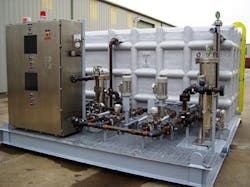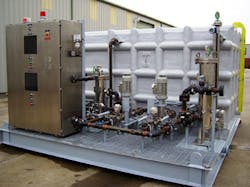To ensure problems are minimised during the operation of new water treatment plants, the commissioning phase should not be underestimated. This article details how the process plays out in Australia, including a case study on the commissioning of inlet water pumps in Queensland.
By Amin Almasi
In practice, the commissioning process comprises the integrated application of a set of engineering techniques and procedures to check, inspect and test every component of a water treatment plant. This is from individual functions, such as instruments and equipment, up to complex items such as modules, subsystems and systems. Commissioning activities, in the broader sense, cover all activities from end phases of the construction and assembly, until the final handover of the water treatment unit (or plant) to the operation team, including sometimes an assisted operation phase.
Pre-commissioning
Pre-commissioning is the series of processes carried out on the facilities before the final commissioning, start-up and operation are introduced. Pre-commissioning is the stage that involves the final cleaning activities and the verification of functional operability of elements within the system, by subjecting them to a set of simulated operational conditions, to achieve a state of readiness for commissioning.
Pre-commissioning usually requires energisation of equipment and the introduction of the "Permit-to-Work" systems. Some examples include the running and entire testing of systems. This is as well as the testing of emergency shutdown and control systems.
Commissioning Plan and Strategy
A detailed commissioning plan should be created to methodically check every piece of equipment, instrument, control and interlock. This is to reduce the impact of potential problems, which otherwise may have been encountered during the startup and the first operation. Like all things in the real world, the commissioning plan should be adjusted to reflect equipment and unit availability, delays, limitations and deficiencies. It is not for historic data or any other target except it should actually be used as a monitoring and control tool.
This should identify risks and areas of concern that could cause problems or delays. In case of a delay in commissioning activities, it should be explained in an updated plan (or an associated report), not only the reasons for variations to the commissioning plan, but also how the team intend to recover from delays.
Important topics in commissioning planning are commissioning strategy, system boundary definitions, estimating concepts and temporary facilities.
The commissioning strategy and plan should be kept as simple as possible. At the end of the construction phase the whole team should look to commissioning leader(s) and manager for guidance to prepare facilities for start-up. The commissioning management team is expected to give guidance based on an honest and realistic plan.
A commissioning progress report should cover the following four sections:
- The completion progress and status from the construction
- The commissioning in progress
- The commissioning complete sections cover their punch list status
- The fully-commissioned sections, ready for hand-over to operation team, or handed-over and under operation.
A major task of any commissioning team is to study the facilities under construction and installed machineries and packages. This is to see if the design and construction is correct and suitable for operation. They should flag any issue as early as possible to detect any hidden problems. Corrective actions are required during commissioning. All actions and modifications should be based on facts.
Machinery Problems in Water Treatment Plants
Each machinery or equipment package has its own sets of problems and issues. Often an issue could show itself in the commissioning stage or a short time after the start-up. As an example, an inadequate inlet strainer or filter is a serious problem for some water pumps.
The design engineers do not want the water treatment process or machinery to fail, but often the lack of expertise in some areas (such as inlet strainer designs) transfers the failure to a downstream machinery at the start-up (or a short time of operation).
Cost of the properly specified and designed inlet filters and strainers incurs a one-time capital expenditure. However, failure of machineries and particularly critical water pumps is an ongoing expense. This can disrupt production and incurs the high cost of lost profit opportunities. These can recur many times during the life of a water treatment plant from the silent root cause for failure.
Cleanliness is a significant factor for machinery reliability. Proper credit should be given for this in the pre-commissioning and commissioning. For example, after ingesting only a few tablespoons of particles and dirt, some types of machinery might be in serious trouble; for some others it could result in permanent (extensive) damages.
"As-Commissioned" Documents
Project documents (such as P&IDs) undergo several revisions during the engineering, procurement, construction and commissioning of a water treatment plant and a typical sequence of revisions could be as follows (there may be further revisions between each stage):
- Issued for Review
- Issued for Approval
- Issued for Design Review (and HAZOP, if applicable)
- Issued for Construction
- As-commissioned.
During the engineering design, there are so many aspects that cannot be visualised sitting in an office. The site construction and commissioning team typically uses the "Issued for Construction" drawings and documents to construct and complete a water treatment plant.
During the construction phase and particularly at the completion phase or pre-commissioning, many surprises spring up. Sometimes, plant construction material and equipment such as valves, piping, pipe fittings and instruments, for example, may not be exactly according to the specifications raised in the engineering phase.
This is either due to either human error, unsuitability or non-availability of a particular type of material or item considering the schedule or details of the plant commissioning. Some modifications have to be done to meet deadlines for plant commissioning.
In short, everything is not as ideal as it should be and alternative solutions are required. Also, there may be errors and changes during the engineering design itself, and these need to be rectified during the construction phase and consequently the completion and commissioning.
Based on the above-mentioned, the need of "As-Commissioned" drawings and documents arises. As the name suggests the drawings reflect what has been actually commissioned at the plant.
Preparing an "As-Commissioned" document (or drawing) starts by "red-lining" the latest "Issued for Construction" document (or drawing), by a commissioning engineer having an experience of engineering and construction based on the actual commissioned plant. The engineer should mark the document with what has been constructed and commissioned, as opposed to what should have been. Some typical mark-ups for an "As-Commissioned" documents could be as follows:
- Changed valve location, valve type and valve details
- Changes in piping which could mean that the sequence of pipe branches tapped from a main header has been altered during construction or commissioning
- Deleted lines based on the commissioning teams understanding that these are unnecessary or even could be problematic
- Provision of additional permanent drain and vent connections based on the commissioning requirement.
- Provision of additional tapping on piping, considering future requirements or other reasons
- Addition or deletion of permanent instruments based on commissioning requirements
- Changes in instrument type, instrument locations, hook-up details, for example due to the commissioning instrument expert's opinion on its functionality
- Addition or deletion of nozzles on equipment (such as tanks, vessels, etc) due to the requirement put forward by the commissioning team
- Possible relocation of equipment due to site constraints which were not envisaged during the engineering phase. This typically involves elevation changes of equipment.
After documents are "red-lined" for the plant or unit, these documents are corrected and back-checked against the red-line mark-ups by the concerned engineering team and then issued as "As-Commissioned ".
Case Study – Commissioning of Inlet Water Pumps in Queensland (Australia)
In a complex water treatment plant, the raw water required was provided from a lake nearby. Submersible pumps were installed in the lake to deliver the water. The pumps were protected from coarse solids on the lake via stainless steel screens. The aperture size of stainless steel screens was very small, about 3 mm.
Commissioning and operation representatives were highly concerned that in a major algae outbreak or similar situations the suction screen could be blocked. This could result in unscheduled shutdown of pumps and consequently plant down time. Operational experiences at other sites backed this concern.
After investigations, it was found that a nearby plant used the same lake for raw water. The pumping systems employed 6 mm holed suction screens that have periodically blocked up and needed to be physically removed and cleaned. The difference in this system was that the operation team cannot easily be able to access these 3 mm stainless steel screens at the bottom of the lake.
The pump vendor advised that the pumps could handle soft solids up to 55 mm, any hard objects such as rocks have a potential to damage the pump. It was noticed that the intake pipes and screens were sitting above the bottom level of the lake.
There was also a trench in front of that; any sizable rocks or larger debris would be more likely to settle in the trench rather than make it through any holes in the suction screen.
The operation opinion was that these suction screens should protect the pumps from coarse solids only and the screen size was too small. It was an example of errors in the design stage, which left undetected until the commissioning.
The operation team proposed to drill holes (50 mm) in the suction screen while the system was in pre-commissioning stage (and the access was easy) to prevent suction screens blocking up in during an algae outbreak or similar event.
A redesign of wedge-wire suction screens was the ideal solution, which should be done by the contractor and mesh designer. The re-designed suction screen should be sent for the installation before the commissioning. This was the preferred solution if the design and procurement process of new suction screen can be matched with the commissioning schedule.
However, since there were time constraints that mandated a fast solution (or temporary option) then the concept of cut holes was reviewed by commissioning team to find if it could be acceptable. It was not feasible to put the commissioning of all the system and water treatment plant on-hold to receive new wedge-wire suction screens.
After a thorough review, the concept of cut holes in the suction screen was accepted (as mentioned above) by the commissioning team. However, it was concluded that 50 mm was too large; with such large cut holes it would possible to face with operational risks and integrity problems.
The final decision was 25 mm cut holes with 60 mm spacing from each other (60 mm minimum spacing between holes). The water pumping system was commissioned using suction screens with 25 mm cut holes as above-mentioned. The startup and operation were successful.
The contractor was informed that the suction screen design was not correct and they needed to redesign wedge-wire suction screens. They started their investigations, redesign and procurement process of new suction screens.
These were received some months after the commissioning. The replacement of wedge-wire suction screens was done at the first overhaul of the water pumping system.
Amin Almasi is lead rotating equipment engineer at consulting services provider, WorleyParsons Services in Brisbane, Australia. Email: [email protected]
More Water & WasteWater International Archives Issue Articles




